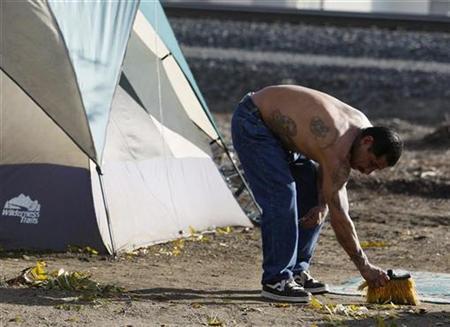
A man sweeps the area outside his tent with a broken broom at “tent city”, a terminus for the homeless in Ontario, a suburb outside Los Angeles, California December 19, 2007. REUTERS/Lucy Nicholson
WASHINGTON (Reuters) – President-elect Barack Obama has vowed to help middle-class U.S. homeowners facing foreclosure, but he has said little about how he will help low-income families made homeless by a worsening economy.
Obama has spoken broadly about boosting affordable housing and restoring public housing subsidies. But with economists forecasting a deep recession in 2009, he may find it hard to find the money to fulfill those promises soon.
At the same time, advocacy groups and the country’s czar for combating homelessness say immediate action is needed to halt the foreclosures of tens of thousands of homes and rehouse thousands of families amid the worst financial crisis since the Great Depression of the 1930s.
“President-elect Obama understands the economy will only get back on track if we end the foreclosure crisis. And he realizes that part of ending the crisis is both preventing and ending homelessness for families losing their homes,” said Jeremy Rosen of the National Policy and Advocacy Council on Homelessness.
It is a quandary that will require help for the overall economy to aid people who slide into homelessness because they lose their jobs. Measures will also be needed to address the mortgage crisis, especially foreclosures on rental properties that house lower-income residents who then wind up homeless when their apartment buildings are repossessed.
Homeless advocacy groups have called for targeted housing subsidies that help homeless families get back into more permanent accommodation as well as helping those on the brink of foreclosure. But Obama will need to do more, and there are no magic wands.
Families are flooding homeless shelters across the United States in numbers not seen for years, camping out in motels or staying with friends and relatives, homeless advocates say.
“There are lots of families hemorrhaging into homelessness and we need to figure out how to put a tourniquet on the hemorrhaging,” Philip Mangano, the homelessness czar appointed by President George W. Bush in 2002, told Reuters.
There is little time to waste. The U.S. unemployment rate is at a 14-year high and more job losses are forecast, while the Mortgage Bankers Association says nearly 1.5 million homes are in the process of foreclosure.
The U.S. Congress approved a massive housing market rescue bill in July that sets aside $3.9 billion that can be used partly by local authorities to buy foreclosed properties. Those could potentially house homeless families.
Mangano, whose official title is director of the Interagency Council on Homelessness, described the $3.9 billion as an “opening salvo” and said the new administration and Democratic-controlled Congress must be prepared to move quickly to invest more money to help homeless families and slow the flood of foreclosures.
MARIA’S STORY
While the latest official figures show the number of homeless declining by 12 percent from 2005 to 2007, Mangano said there was sufficient data and anecdotal evidence to suggest that family homelessness was now on the rise.
In New York, the number of newly homeless families entering shelters has hit a record high, according to the Coalition for the Homeless, which says 1,464 families entered the New York shelter system in September.
San Francisco’s four shelters are “beyond full,” according to Paul Boden of the Western Regional Advocacy Project, whose organization has identified 450 families with 800 children living in single-room hotels in the city.
In Virginia’s Fairfax County, one of the richest counties in the United States, there are about 100 families on a waiting list to enter shelters, local officials say.
Maria Stephens, 38, a mother of three young boys, lived in one of the Fairfax shelters for seven months after two landlords were foreclosed on and she lost her job as a mortgage underwriter earning $80,000 a year.
“It was a hell of an experience for me. I went from having my own bathroom to having to share a bathroom with five families,” said Stephens, who now works in a restaurant making $9 an hour and was helped by a local group, Reston Interfaith, to move into temporary accommodation in July.
The public perception is that newly homeless families borrowed money they were unable to repay or were the victims of greedy banks that sold them mortgages they could not afford.
But homeless advocates say most are actually renters whose landlords were foreclosed on, or who lost their jobs, and were then unable to find the first and last month’s rent and security deposit to secure new accommodation.
Local and state homeless groups have seen a 61 percent rise in homelessness since the foreclosure crisis began in 2007.
“There is an uptick, no question about it, in homelessness in most places in our country,” Mangano said.
(Editing by Cynthia Osterman)
By Ross Colvin – Analysis
Wed Nov 12, 2008 1:07am EST
Source: Reuters